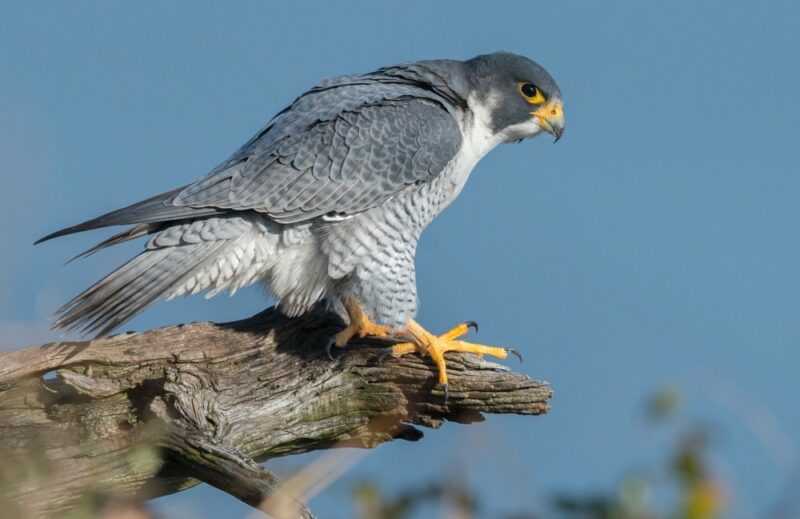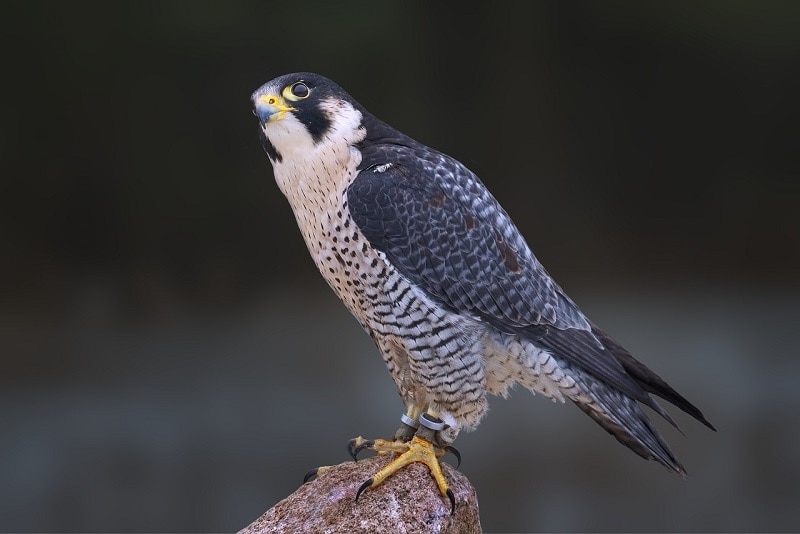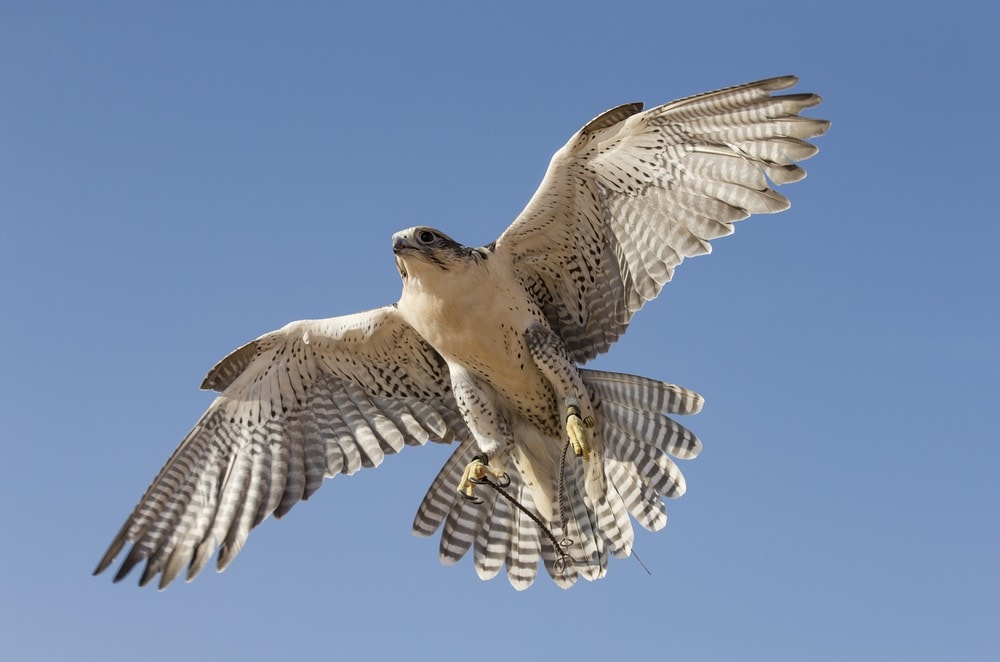Peregrine Falcon: Field Guide, Pictures, Habitat & Info
Last Updated on


Quick Facts about Peregrine Falcons
| Habitat | Coastlines and towns |
| Diet | Birds and rodents |
| Behavior | Aerial hunter (diving) |
| Nesting | Cliffsides |
| Conservation | Low risk |
| Scientific name | Falco |
| Lifespan: | 12–15 years |
Peregrine Falcon General Description
The peregrine falcon is a large bird of prey with a dark gray coat and head, contrasted with a cream-white breast and throat. Sharp yellow talons and a hooked beak give this species an intimidating look, and they are a common member of the falcon family.

Peregrine Falcon: Range, Habitat, Behavior, Diet, and Nesting
Range
This bird has been found on every continent except for Antarctica, with great prominence in North America. The range of the peregrine falcon spans from the coastal edges of Greenland for mating to their non-breeding grounds down in the southernmost point in Mexico. It migrates through the vast majority of the United States, but it may be seen living throughout the year on the northeastern coast or along the Pacific.
Habitat
Peregrine falcons often live in coastal towns or ocean shorelines. However, they do stake out their territory in deserts, which primarily reside in the American southwest.
Behavior
In terms of their hunting habits, these falcons are excellent in the art of aerial diving. They can fly nearly 70 miles per hour to pursue their prey!

Diet
As birds of prey, falcons are always on the search for smaller and medium birds, such as sparrows or finches. But they also have a taste for rodents that can be found both in the wild and in the city.
Nesting
Similar to other falcon species, the peregrine chooses to nest up high on cliff sides and rocky terrain. Their nests are about 9 inches in diameter and approximately 2 inches deep. Peregrine falcons may also mate for life.
How to Find Peregrine Falcons: Birdwatching Tips
What to Listen For
The calls of peregrine falcons are mid-length screeches that elevate higher in tone. However, they do sound quite similar to other birds of prey.
What to Look For
Always be on the lookout for large, brushy nests lodged into tight spaces or even on telephone poles. Here, you may see a peregrine falcon swoop back and forth to feed its young. Keep an eye out for its yellow coloring near the eyes and feet; they’re the most eye-catching features on its body!
When to Look
Peregrine falcons can be found throughout the day, but it will be difficult to see them at dusk or dawn due to their coloring. Therefore, daytime searches might be your best bet to find one.
Attracting Peregrine Falcons to Your Backyard: Tips & Tricks
Generally speaking, falcons do not come close to lawns or backyards unless there is an abundance of rodents and or medium-sized birds. Your only chance at attracting them would be to bring in multiple bird species that they can hunt. However, this isn’t advised as they could potentially target a small dog or cat instinctively.
Peregrine Falcon Conservation: Is This Bird Threatened?
In the 1900s, the peregrine falcon was losing a lot of its population in the eastern U.S., but the species has bounced back considerably since then. Now, it doesn’t have much threat in terms of its numbers. However, the climate shifts in the north are affecting migration patterns and will continue to do so in the future if this stays consistent.


Conclusion
Peregrine falcons are an incredible bird for birders and non-birders to get a glimpse of. Their gray coat and yellow highlights give them an iconic appearance, especially where they live near coastal towns. If you want to search for one yourself, make sure to listen for calls and check their habitat thoroughly. Good luck!
Featured Image Credit: Harry Collins Photography, Shutterstock
Table of Contents
- Quick Facts about Peregrine Falcons
- Peregrine Falcon General Description
- Peregrine Falcon: Range, Habitat, Behavior, Diet, and Nesting
- How to Find Peregrine Falcons: Birdwatching Tips
- Attracting Peregrine Falcons to Your Backyard: Tips & Tricks
- Peregrine Falcon Conservation: Is This Bird Threatened?
- Conclusion
About the Author Robert Sparks
Robert’s obsession with all things optical started early in life, when his optician father would bring home prototypes for Robert to play with. Nowadays, Robert is dedicated to helping others find the right optics for their needs. His hobbies include astronomy, astrophysics, and model building. Originally from Newark, NJ, he resides in Santa Fe, New Mexico, where the nighttime skies are filled with glittering stars.
Related Articles:
10 Types of Hummingbirds in Arkansas (With Pictures)
8 Types of Hummingbirds in Nebraska (With Pictures)
5 Types of Hummingbirds in Idaho (With Pictures)
3 Types of Hummingbirds in Mississippi (With Pictures)
8 Types of Hummingbirds in Kansas (With Pictures)
5 Types of Hummingbirds in West Virginia (With Pictures)
5 Types of Hummingbirds in Ohio (With Pictures)
Where Do Nuthatches Nest? Nuthatch Nesting Habits Explained
